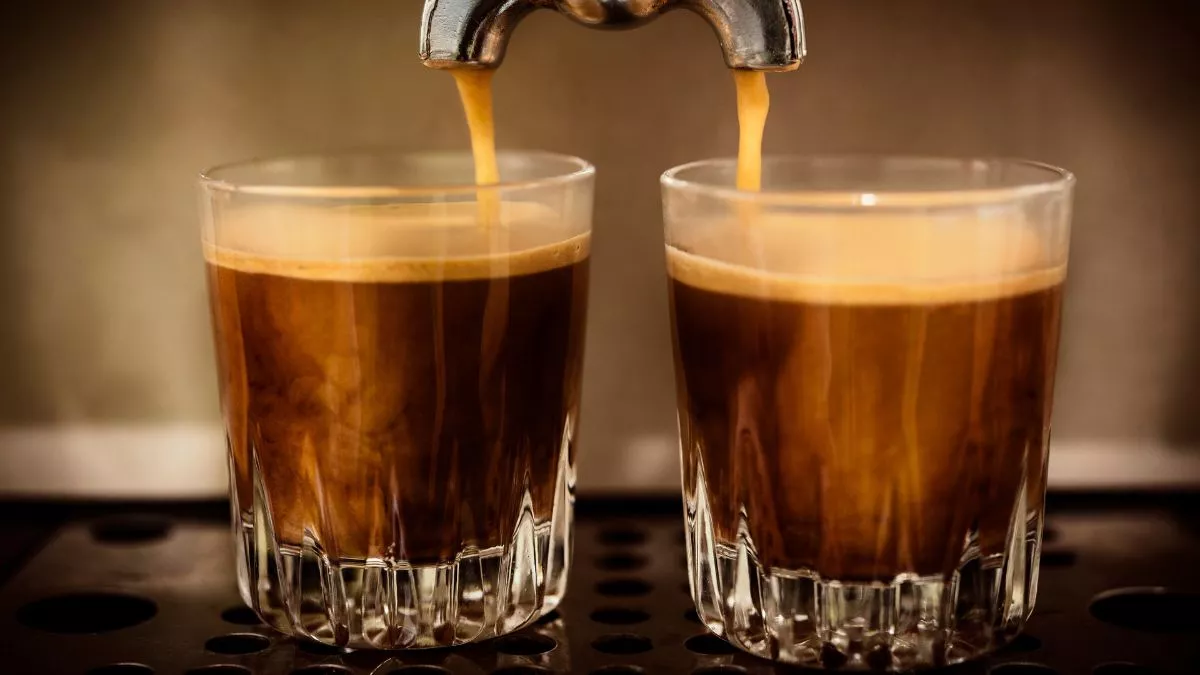
Espresso is supposed to be dispensed fairly quickly; not dripping too slow, and definitely not crazy fast. To put this into perspective, one shot of espresso should be done in about 30 seconds from when you first push the button.
This should typically amount to 25 – 30 ml. So you should basically aim for 25 to 30 ml of liquid in those thirty seconds. If it is more than that, then your espresso is dispensing too quickly.
When this happens, you will notice that the liquid becomes light even before the 30 seconds are up, and the resultant coffee will have a rather sour taste. This is because your coffee maker has extracted everything from your coffee grounds, including the unpleasant tasting ones.
Why is my Espresso dispensing too quickly?
If your espresso is coming out too fast, it could be due to a number of reasons. These include:
1. Grind size
If you have more than 30ml of liquid in your cup after 30 seconds, you may want to check the grind size of your grounds. Your coffee grounds should not be too big or too fine, or it may lead to some issues.
Too fine espresso: If your grounds are too small, water will experience some resistance while flowing through the coffee bed due to the tightly packed espresso.
As a result, it will look for the easiest path with weak spots where it can penetrate. The pressure from the water leads to the formation of a tunnel (channel) through which all of the water flows.
As you’ve probably already deducted by now, this means that the water does not touch most of the coffee grounds, so they are consequently under-extracted.
During the brewing process, you will likely see nothing dripping out at first, and then the liquid will start flowing suddenly and quickly. The resultant espresso is usually very weak.
Too coarse espresso: If your espresso grind size is too coarse, the bed will have several little gaps between the coffee grounds even after tamping. Water will have an easier time flowing through this type of espresso as the gaps do not offer any resistance.
As before, the resultant liquid will be under-extracted. This is because the water passing through the gaps does so too fast, meaning that you don’t get all the useful qualities you want. The resultant espresso is very sour and does not have that enjoyable thick texture of good coffee.
If you are using pre-ground coffee, make sure the label says it is ground for espresso. Coffee that is meant for pour-over or french press methods tends to be too coarse, so it won’t work well.
You can adjust the grind size if you are grinding your own coffee. Even a small adjustment can make a big difference when it comes to espresso, so you can go a touch coarser or finer depending on the size of your grounds.
Keep in mind that some grinders are not designed for grinding espresso. Most grinders can produce just about the right size for espresso, but those that are meant for filter coffee will give you a difficult time adjusting them finely enough to get the right size for your espresso.
For the best results, you may want to consider investing in a single-dose grinder or a grinder dedicated to espresso.
2. Basket size and amount of coffee
Ensure that you get the ratio of liquid to grounds right and that you’re using the right basket size for your coffee grounds.
Italian-style espresso is unique in that it uses fewer coffee grounds than the rest of the world. The espresso you are probably used to uses a coffee/basket size ratio of 1:1.5 – 1:2.5. So for one gram of coffee grounds, you get 1 ½ to 2 ½ grams of liquid. That means that one shot of espresso uses about 14g of coffee grounds.
Portafilter baskets come in several different sizes. The idea is to get a basket that matches the amount of coffee you’re using.
You can reduce the grounds by a few grams than is initially intended for your basket, but cutting back by up to 50 percent of its capacity will not work well.
This is because there will be too much space between the particles, so the coffee won’t form a solid bed that offers the ideal resistance. Similarly, if you overload a small basket with too many coffee grounds, the liquid won’t channel through because of over-compression.
You can usually find the capacity of the basket written somewhere on it. Don’t worry if yours doesn’t show it. You can easily determine the capacity by filling it up and then measuring the number of coffee grounds it can hold.
In fact, it is probably wise to always measure your basket’s capacity even if it is labeled, as some of those measurements follow the Italian style. If the basket simply says “double” or “single” and it’s based on the Italian espresso, you will end up using a completely different brew ratio than you wanted.
3. Tamping technique
You should tamp your coffee grounds after putting them in the basket. You can do this using a simple device known as a tamper.
A tamper compresses the espresso and pushes out the air between the particles. Too much air between the grounds can cause water to flow through easily because of the lack of resistance, leading to uneven extraction.
You don’t have to tamp too hard to get the desired results, as maximum compression is achieved rather fast.
Some people argue that pressing too hard can lead to over-extraction because the water stays in contact with the coffee grounds for too long. A good rule of thumb is to tamp fairly hard while being careful not to overdo it.
The recommended pressure is 20 to 30 lbs. of pressure. To find out how much that is, simply place your basket on a scale and then press from zero until you see the number you want on the scale.
Tamping slightly hard is usually not an issue because the grounds eventually swell up and sort of compress against each other. You’ll notice that the liquid comes out a little faster at the beginning, but this will resolve itself fast enough if the grind size and basket size are correct.
However, it’s still advisable to use the right pressure to avoid messing up your shot of espresso with the first spout of liquid.
4. Loose basket
Another reason your espresso is flowing too quickly might be a basket that’s not locked in. Some machines are a little difficult to determine whether the basket is properly locked in and sealed.
Just watch the liquid when it starts dispensing too quickly and see where it is coming from. Is the liquid flowing around the exterior or is it actually passing through the filter?
If it is coming from the outside, the problem is with the basket’s seal. It means that the basket is not secured tightly enough. You can correct this by simply twisting the basket a little further.
If you don’t get anywhere with this, check if the basket is not damaged or if it’s the right size for your machine.
How resistance affects dispensing speed of espresso
The speed at which your machine dispenses espresso depends primarily on resistance and pressure. The pressure on most simple machines is not adjustable, so it all depends on the resistance provided by your coffee bed.
Even if the pressure on your machine is adjustable, it is not a good idea to turn it all the way down just to achieve the ideal flow rate. You are better off leaving the pressure as it is and adjusting the coffee bed’s resistance instead.
However, there are lever espresso machines with a lever that you can pull to control the pressure. This type of machine might be suitable if you need complete control over the pressure.
Generally, it is always better to aim for the right balance of resistance and pressure. If your bed offers little resistance and you are working with low pressure, your espresso will be very weak with a rather sour taste.
If you have a high resistance with the same low pressure, the espresso may take too long to dispense. Sometimes it might not come out at all.
On the other hand, if your coffee bed has a high resistance and the pressure is high, the liquid will likely channel.
The key is finding the right balance with trial and error.
Bonus Tip: Use a coffee scale:
Using a coffee scale can go a long way toward figuring out what’s happening.
Any scale that has an inbuilt timer and is accurate to 0.1g will work, but it is important to find one that is low profile enough to fit a cup between the portafilter and the scales and is still capable of fitting on your espresso machine’s drip tray. Timemore scale is a good example.
Start the timer as soon as you start brewing – from the moment the water makes contact with the grounds and offsets the extraction process.
You don’t want to time from the first drop because the liquid can take longer to pass through extremely fine coffee grounds, which may lead to inconsistency.
Of course, you don’t have to aim strictly for the 30-second count. If your espresso dispenses in 29 seconds, that is okay as long as it doesn’t have a sour taste.
